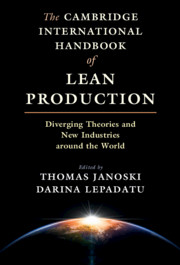 The Cambridge International Handbook of Lean Production
The Cambridge International Handbook of Lean Production Book contents
- The Cambridge International Handbook of Lean Production
- The Cambridge International Handbook of Lean Production
- Copyright page
- Dedication
- Contents
- Tables
- Figures and Sidebars
- Preface
- Acknowledgments
- Contributors
- Abbreviations
- 1 Lean Production as the Dominant Division of Labor
- Part I Theories of Lean Production
- 2 Lean Production from the View of Management Theory
- 3 Lean Production – Perspectives from its Primary Caretaker, Industrial Engineering
- 4 The Industrial Relations Perspective on Lean Systems, Workers, and Unions
- 5 Contested Views of Lean Production from the Social Sciences Perspective
- 6 The Lean Labor Process
- Part II Lean Production across Industries
- Part III Lean Production Around the World
- Name Index
- Subject Index
- References
6 - The Lean Labor Process
Global Diffusion, Societal Effects, Contradictory Implementation
from Part I - Theories of Lean Production
Published online by Cambridge University Press: 11 March 2021
- The Cambridge International Handbook of Lean Production
- The Cambridge International Handbook of Lean Production
- Copyright page
- Dedication
- Contents
- Tables
- Figures and Sidebars
- Preface
- Acknowledgments
- Contributors
- Abbreviations
- 1 Lean Production as the Dominant Division of Labor
- Part I Theories of Lean Production
- 2 Lean Production from the View of Management Theory
- 3 Lean Production – Perspectives from its Primary Caretaker, Industrial Engineering
- 4 The Industrial Relations Perspective on Lean Systems, Workers, and Unions
- 5 Contested Views of Lean Production from the Social Sciences Perspective
- 6 The Lean Labor Process
- Part II Lean Production across Industries
- Part III Lean Production Around the World
- Name Index
- Subject Index
- References
Summary
In 1930 the founder of Toyoda Automatic Loom Works, Toyoda Sakichi, instructed his eldest son, Toyoda Kiichirō, to research the auto industry with a view to entering it. In 1933, Kiichirō announced that the company would begin making cars, stating: “We shall learn production techniques from the American method of mass production. But we will not copy it as is. We shall use our own research and creativity to develop a production method based on our own country’s situation” (quoted in Ohno 1988: 91). That situation included a small market that could not justify huge volumes with dedicated machinery, coupled with severe resource constraints. Their goal was to develop a production system based on lower volumes with low inventories. Toyota didn’t implement its first compete just-in-time system until 1958 and was not able to fully debug its kanban (continuous flow) system until 1962, after which it was adopted companywide (Tolliday 1998).
- Type
- Chapter
- Information
- The Cambridge International Handbook of Lean ProductionDiverging Theories and New Industries around the World, pp. 150 - 176Publisher: Cambridge University PressPrint publication year: 2021
References
- 2
- Cited by


